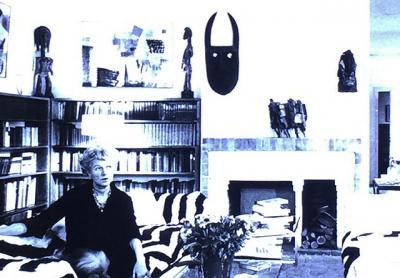Guggenheim Plots The Transformation of Pollock's ‘Alchemy’

“Visionaries,” the new Solomon R. Guggenheim Museum exhibition, which opened on Saturday, celebrates the avant-garde instincts and connoisseurship of the people who shaped the museum’s collection. Although it contains precious few American artists, that hasn’t stopped its curators from celebrating one American painting in particular, Jackson Pollock’s “Alchemy.”
The painting is one of the last in the exhibition, placed in the museum’s highest bay at the top of the rotunda. It almost feels like a pilgrimage to get there, but what a journey. The museum’s collection of 19th to early 20th century paintings looks fresh and inspired, with a deep dive into such artists as Vasily Kandinsky, of whom the museum has a great number of holdings.
“Alchemy” returns to the United States from the Peggy Guggenheim Collection in Venice for the first time in a half century. It appears much as it did before it left, the beneficiary of an extensive and exacting cleaning in 2014 in Florence. Before its cleaning, the painting had been dulled by layers of dust and residue.
On its own, “Alchemy” stands as both an apex of Pollock’s drip-painting style, and a worthy representative of American midcentury Modernism in a European venue. But the museum took it one step further with an auxiliary exhibition in its basement devoted to both its importance in art history as well as its cleaning, giving viewers an inside look at how modern paintings are handled in state-of-the-art conservation labs.
According to the Guggenheim, the cleaning consisted of stabilizing the surface where the paint may have separated from the canvas, micro-vacuuming the dust, and the application of special cleaning solutions designed specifically for the materials in the paint.
The analysis of the painting by the conservation team revealed that Pollock used both house enamel paint and oils in the work, and also ground sand and pebbles into the canvas. The surface analysis, which is shared on an interactive touch screen monitor as well as with a three-dimensionally printed facsimile, shows the depths of his paint application and a rich topography that gives his paintings their characteristic complicated depth and presence.
The touch screens, some of them focusing on the conservation and others on the art historical background, offer detailed biographical information, reproductions of important archival documents, and high-resolution images of “Alchemy” before and after restoration, which can be zoomed into to draw out the tiniest of details.
A video showing the conservators at work in their studio includes Peggy Guggenheim discussing what Pollock meant to her and the European and American art world several decades ago. It’s a fascinating document that travels back and forth through past and present in a smooth and coherent fashion.
Also on view are archival photographs of the artist in his studio and the familiar paint cans left in the studio at the time of his death, which are typically on view at the Pollock-Krasner House and Study Center in Springs.
Carol Stringari, the deputy director and chief conservator at the Guggenheim, and Susan Davidson, senior curator of collections and exhibitions, put together a rich and immersive mini-exhibition that demonstrates the complexities that can be mined from just a single artwork.
The exhibitions will remain on view through Sept. 6.
